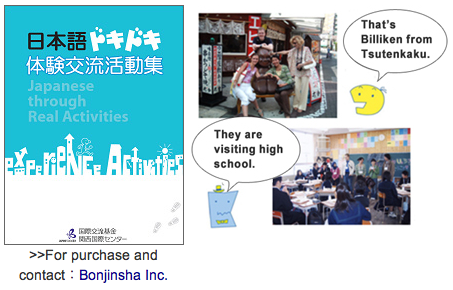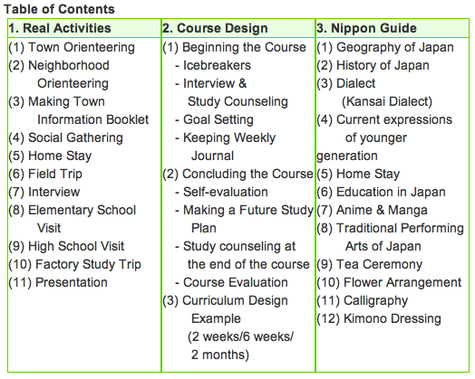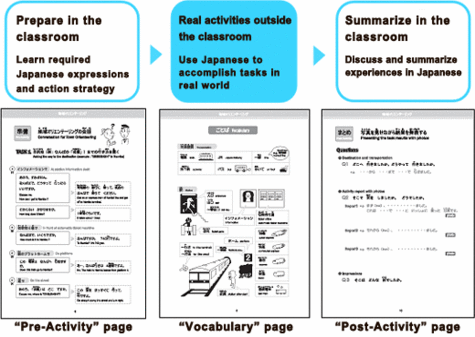Activity Reports:Japanese-Language Education Overseas:New Teaching Material from the Japanese-Language Institute, Kansai "Nihongo "Doki-Doki" Taiken Koryu Katsudo-shu: Japanese through Real Activities"
Nanae Kumano, Japanese Language Education Specialist,
The Japanese-Language Institute, Kansai
The Japanese-Language Institute, Kansai has been conducting short-term study programs of two to six weeks, inviting high-school students, college students, and adults who are learning Japanese overseas to Japan. These learners are visiting Japan with great expectations for real-life experiences of what they have learned from books about Japan and conversation with Japanese people in Japanese. In order to address their needs and to encourage them to continue their learning of Japanese after they return to their countries, the short-term study programs have been aiming to help them (1) utilize their Japanese skills that they have learned in their countries, (2) deepen their understanding of Japan through real activities, and (3) find incentives for continued learning. To accomplish these aims, the courses have been designed to focus on real activities and exchange with Japanese people. Such activities for some ten years have been compiled into the new material, "Nihongo "Doki-Doki" Taiken Koryu Katsudo-shu: Japanese through Real Activities." This book is full of useful ideas for learners to acquire the ability to take action in Japanese through interaction with Japanese people in "out-of-class" activities.
Part 1 Interaction Activities: Connecting "Inside" and "Outside" of Classroom
Part 1 introduces 11 activities that utilize the resources outside the classroom. Students can use their Japanese comprehensively through the activity flow: (1) preparation in the classroom; (2) activity outside the classroom; and (3) summarization of the activity in the classroom. There are also tips for teachers who coordinate the activities to carry out the activities smoothly.
Part 2 Course Design: Designing activity-oriented course
In case of an activity-oriented course, teachers may find it difficult to evaluate student activities. To avoid such difficulty, work sheets are provided for learners to set their learning goals, record their daily activities, and evaluate their own activities. In addition, know-how is also provided for teachers to support their students. Furthermore, examples of course schedule of five days to two months are provided to suggest how to incorporate activities into the course depending on the length of the course and the circumstances of learning institutes. One example combines learning activities with other Japanese-language subjects, and another incorporates part of exchange activities into intensive Japanese-language course.
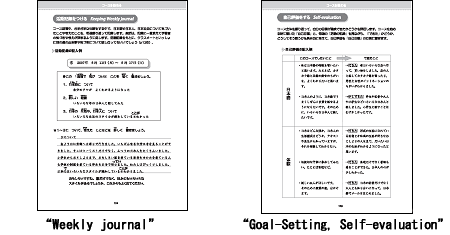
Part 3 Nippon Guide: Introduction of Japan by using PowerPoint
Part 3 is a guide to the basic knowledge of Japanese culture and society that can be utilized prior to the activities. By fostering interest and awareness, learners can participate in the activities more proactively. In addition to the printed material, an attached CD contains a PowerPoint file that includes quiz, photographs and illustrations for the guide. A wide variety of Japanese culture, from history and education to current expression of younger generation and anime/manga, can be introduced with simple Japanese.
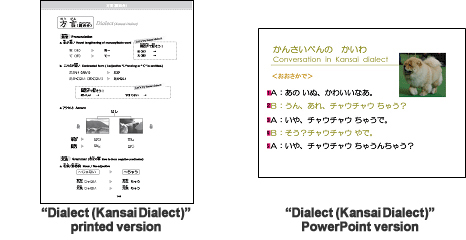
Advantages of Japanese-language learning through exchange activities
In the course of implementing programs at the Japanese-Language Institute, Kansai, we have found that Japanese-language learning through exchange activities has following advantages:
1.With clear purpose and objective of learning, learners are strongly motivated and can participate in activities proactively.
2.By accomplishing tasks through real activities outside the classroom, learners can acquire the ability to take action in the Japanese environment.
3.Learners can have experiences in Japanese at their own language level, so they can have a sense of accomplishment.
4.Through real activities, learners can recognize and become aware of their own level of Japanese language proficiency.
5.Through real interaction with people and society outside the classroom, learners can enrich their understanding of Japan.
Most of all, real activities are "fun" for learners. They may be excited and nervous outside the classroom, but they show unexpected abilities, learn more than ever with little awareness that they are "studying" language, and work on activities more proactively.
We hope that more and more Japanese-language institutes not only in Japan but also overseas will include real interactive activities by utilizing resources of Japanese people and things, to stimulate and motivate the Japanese-language classes.
Related Articles
Back Issues
- 2025.9.30 The 51st Japan Found…
- 2025.9.30 The Japan Foundation…
- 2025.9.30 Bringing the World C…
- 2025.9.30 The 51st (2024) Japa…
- 2025.9.30 Japan Foundation Pri…
- 2024.5.24 The 50th Japan Found…
- 2024.3. 4 Movie Theaters aroun…
- 2023.4.10 The 49th Japan Found…
- 2023.3.28 JF's Initiatives for…
- 2023.1.27 Living Together with…


